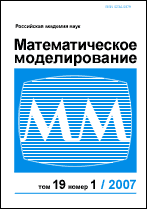|
This article is cited in 2 scientific papers (total in 2 papers)
Mathematical models and computer experiment
Reynolds averaged Navier-Stokes numerical simulation of 3D ventilation flows
K. V. Belyaev, D. A. Niculin, M. Kh. Strelets
Russian Research Centre "Applied Chemistry"
Abstract:
Effect of the air-terminal design on the room ventilation efficiency for different contaminating gases is studied on the basis of the 3D Reynolds averaged Navier–Stokes (RANS) equations. Two specific types of the air-supply terminal devices are considered: a simple conical diffuser with different angles and so-called jet-killer, i.e., a plate located beneath the inlet air opening. A contaminant exhaust is located at the room floor and the outlet
openings are placed at the room ceiling. The computations are performed for a wide range of the ventilating air flow-rate, diffuser angle, for two contaminating gases, $\mathrm{CH}_4$ and $\mathrm{CO}_2$. Both nominal (steady) and emergency regimes of the system operation are studied, the latter corresponding to the, system turn on for cleaning of a contaminated room. The results obtained demonstrate a significant role of the air-terminal design and air/contaminant densities and flow-rates on the flow pattern and air quality in the room. It is shown also that at some specific conditions the problem can have two qualitatively different steady solutions depending solely on the initial conditions.
Received: 25.05.1998
Citation:
K. V. Belyaev, D. A. Niculin, M. Kh. Strelets, “Reynolds averaged Navier-Stokes numerical simulation of 3D ventilation flows”, Matem. Mod., 10:12 (1998), 71–86
Linking options:
https://www.mathnet.ru/eng/mm1349 https://www.mathnet.ru/eng/mm/v10/i12/p71
|

|




 Contact us:
Contact us: Terms of Use
Terms of Use
 Registration to the website
Registration to the website Logotypes
Logotypes








 Citation in format
Citation in format 
